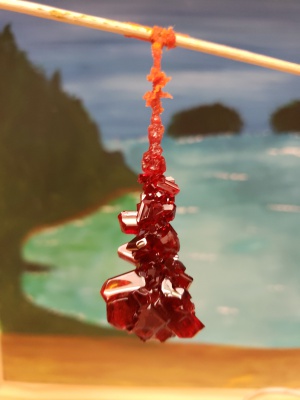Difference between revisions of "Ferricyanide Crystal"
Jump to navigation
Jump to search
(Created page with "==General Procedure== The most general way to grow a crystal includes forming a supersaturated solution by heating up water and adding in the crystal medium, here I used Potas...") |
|||
| Line 10: | Line 10: | ||
# Keep adding until the rate of dissolution decreases( The article above mentions to use about 93g in 200mL of water). | # Keep adding until the rate of dissolution decreases( The article above mentions to use about 93g in 200mL of water). | ||
# Cover the finished solution with something(a watchglass or parafilm) and let it sit overnight. | # Cover the finished solution with something(a watchglass or parafilm) and let it sit overnight. | ||
| + | |||
| + | |||
| + | |||
| + | [[File:20190407_133643.jpg|center| 300px| A picture of the potassium ferricyanide crystal grown by Seth Croslow]] | ||
| + | This is an example of a potassium ferricyanide crystal grown by Seth Croslow using the instructions from above. | ||
| + | |||
| + | Note: Another way to do this would be to make a saturated solution and allow the water to evaporate slowly over time. This may yield a single large crystal instead of a conglomerate of smaller crystals, although it will take significantly longer. | ||
Revision as of 16:03, 18 April 2019
General Procedure
The most general way to grow a crystal includes forming a supersaturated solution by heating up water and adding in the crystal medium, here I used Potassium Ferricyanide, until is doesn't dissolve anymore.
For a general procedure, the following link can be used: How to Grow a Potassium Ferricyanide Crystal
The following is the procedure that I followed:
- Obtain potassium ferricyanide, a 250 mL beaker, a stirplate/hotplate, and a stirbar.
- Begin heating up the water on the hotplate and add the stirbar.
- Once hot, begin adding the potassium ferricyanide (It will take some time for it to dissolve, but it eventually will).
- Keep adding until the rate of dissolution decreases( The article above mentions to use about 93g in 200mL of water).
- Cover the finished solution with something(a watchglass or parafilm) and let it sit overnight.
This is an example of a potassium ferricyanide crystal grown by Seth Croslow using the instructions from above.
Note: Another way to do this would be to make a saturated solution and allow the water to evaporate slowly over time. This may yield a single large crystal instead of a conglomerate of smaller crystals, although it will take significantly longer.
